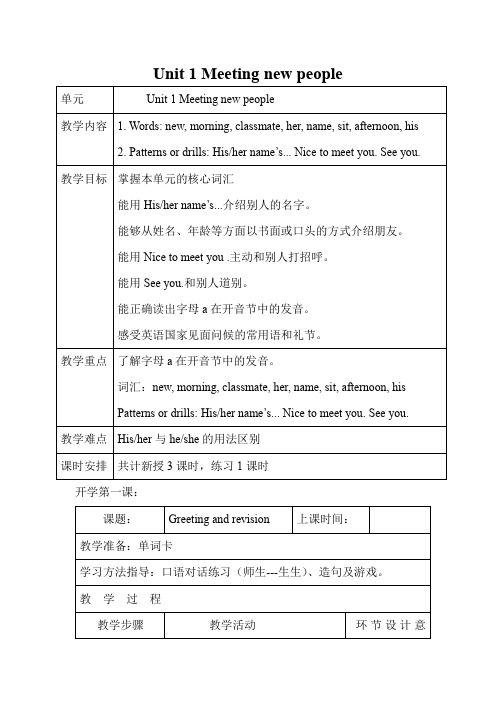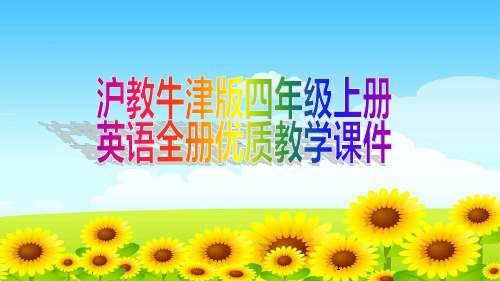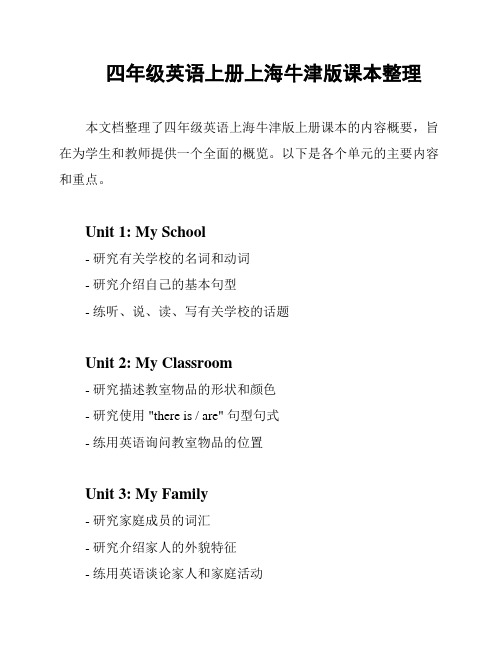四年级英语上册上海牛津版课本整理
沪教牛津版四年级上册英语全册教案(含单元知识点总结)

T: How are you?
Ss: I’m fine,thank you. And you?
T: I’m very well.
T: How is the weather?
Ss: It’s...
T; What food do you like?
Ss: I like ...
引出本课重点句型,举例让学生掌握巩固。
通过看图认读句子,并以两两一组的方式进行认读和表演对话。
Homework
Read the text.
Listen and repeat P.2-3
Recite and copy the two words P3
Blackboard writing design
Unit 1 Meeting new people
E.g. Her name’s Cici.
His name’s Peter.
Work in groups to practice the dialogue .
Work in pairs and show in front of the blackboard.
通过日常问答,培养学生语感,复习巩固。
听录音并模仿跟读,感知对话大意。
课时安排
共计新授3课时,练习1课时
开学第一课:
课题:
Greeting and revision
上课时间:
教学准备:单词卡
学习方法指导:口语对话练习(师生---生生)、造句及游戏。
教学过程
教学步骤
教学活动
环节设计意图及效果分析
Step 1 Greeting
Step 2 Revision
四年级英语上册上海牛津版读物整理

四年级英语上册上海牛津版读物整理本文档整理了四年级英语上册上海牛津版的读物内容。
具体的内容包括但不限于以下部分:本单元主要介绍了学校的情况和学生的个人信息。
学生将研究如何问候和介绍自己,还将了解学校的不同地方和学校活动。
单元二:In the Classroom本单元围绕教室的内容展开,学生将研究一些学科的英文单词,以及如何在课堂上进行简单的对话。
单元三:In the Park本单元以公园为主题,学生将研究有关自然、季节和游玩的词汇,还将了解公园中的不同活动和设施。
单元四:At Home本单元将聚焦在家庭生活方面,学生将研究有关家庭成员、房间和家务的词汇,还将研究如何询问和回答有关日常活动的问题。
单元五:Food and Drinks本单元将为学生介绍食物和饮料的内容。
学生将研究有关不同食物和饮料的词汇,以及如何进行简单的点餐对话。
单元六:My Body本单元将介绍有关身体部位和感觉的内容。
学生将研究相关的词汇,以及如何描述身体不适和感受。
单元七:Celebrations本单元将介绍一些节日和庆祝活动。
学生将研究节日的词汇和庆祝方式,还将了解不同国家和文化中的节日差异。
单元八:Occupations本单元将聚焦在职业方面,学生将研究有关不同职业的词汇,并了解他们的工作内容和职责。
单元九:Our Country本单元将介绍一些有关国家和文化的内容。
学生将研究国家的名称、地理位置和文化特点,以及一些基本的国家标志。
以上是四年级英语上册上海牛津版读物的内容整理。
通过学习这些内容,学生将能够扩大英语词汇量,提高语言表达能力,并了解一些与日常生活相关的话题和文化知识。
最新牛津英语上海版四年级上册知识点整理

最新牛津英语上海版四年级上册知识点整理Module1 Getting to know you Unit 1 Meeting new people生词: eleven twelve thirteen fourteen fifteen sixteen new morning classmate her name sit afternoon his句型:My/His/Her name is ... Nice to meet you. See you. He’s/She’s ... (age) This is my... Good morning/afternoon 语法:形容词性物主代词 my, her, his, your在英语中有物主代词,它可以分成名词性的和形容词性的.形容词性物主代词相当于形容词,置于名词前,在句子中用于修饰名词,做定语,后面必须跟一个名词. 例如:This is my brother. His name is Tom. 这是我的哥哥.他叫汤姆.形容词性物主代词有人称和数的变化,单数形式:my我的,your你的,his /her/its他的、她的、它的. 复数形式:our(我们的),your(你们的),their(他们的). Unit2 Can you swim? 生词:run fast fly draw read write swim jumpbut skate dance cat mouse bird rabbit fish elephant 句型:I/He/She/Kitty/My sister can... I/He/She can’t…Can you/he/she…? What can you/he/she do?A fish can swim. An elephant can ran fast.语法: 1. 情态动词can 意思是“会,能”,表示会做某事. 句子结构:肯定句:主语 + can + do(动词原形)否定句:主语 + can + not + do(动词原形)一般疑问句:Can you/he/she/they run fast?特殊疑问句:What can you/he/she/they do?例如:My friend can ride a bicycle. I can’t swim.My brother can hear the bird. I can’t draw flowers.注:can 的否定有两种书写形式 ca n’t 和 cannot 2. 连词 but But 是个表示转折关系的并列连词,意思是“但是,然而”.1 / 4例如: I can run, but I can’t swim. 我会跑但是我不会游泳.My sister can sing, but she can’t dance. 我妹妹会唱歌但是不会游Unit3 Are you happy?生词: happy hungry thirsty sad full tired bird see drink bottle a new kite look at have some water/biscuits.little stones drink the water very thirsty have a good idea 语法: I’m/He/She/Peter is happy/hungry.Are you sad/tired? Yes,I am/No,I’m mot.Is Kitty thirsty? Yes,she is/No,she isn’t.How do you feel? I’m/We’re...Module2 Me,my family and friendsUnit4 Jill’s family生词:father mother parent brother sister uncle aunt grandfather grandmother grandparent me cousina big family Uncle John’s son Dan’s father语法: I have two cousins. I don’t have any cousins.Do you have any...? Yes,I do. /No,I don’t.How old is your brother? He is 11 years old.Who is this/that? This/That is my uncle/me.Is this your brother? Yes,he is./No,he is n’t.Unit5 My friends生词: shirt T-shirt skirt shorts dress brown green red white black blue pink yellow purple a pair of shortsorange get out tooth/teeth sharp a brown shirt fly a kite an orange dress ride a bike skate afraid语法:I have a black T-shirt. He/She has a pair of brown shorts Unit6 My parents生词: doctor nurse teacher student fireman cook bus driver Jill’s father kid help people fire play with2 / 4语法: What does your father do? He/She is a fireman.What do you/your parents do? I’m/My father is a doctor.Is your sister a nurse? Yes,she is/No,she isn’t.Don’t play with fire. Yes,Mr Xu.Are you afraid of fire? No. I like my job.Module3 Places and activitiesUnit7 At school生词:Playground classroom toilet animal pupil forest first Climb trees teacher’s office an animal school no classroom语法:There be 句型是英语中常用句型,意思是“有”,表示“人或事物的存在”或“某地有某物”.There be 句型的构成形式一般为“There is/are + 某物/人 +某地/时”,表示某地/时有某物/人1.当动词be后所接的名词是单数可数名词或不可数名词时,be 应该取单数is;当其后所接的名词是复数的可数名词时,be用复数are.2.There be 句型中的be 应和其后出现的主语在数上一致,即“就近原则”,如:There are five books,two pens and a ruler in the school bag.There is a ruler,two pens and five books in the school bag.Unit8 At the shop生词: shop tomato(es) potato(es) soup carrot fish meat rice together bread milk water juice candy eggan egg a carrot some juice/tomatoes a pair of magic glasses glasses shop语法:可数名词是可以用来计数的名词.可数名词有单数和复数形式.如:desk-desks, apple-apples等.不可数名词是不可以直接用来计数的名词.不可数名词没有复数形式,只有单数形式.3 / 4如:some bread, a little milk等.What would you like? I’d like a/an/some ---.How much are these? Thirty yuan,please.Here you are. Can I help you? Yes. I’d like ---.Unit9 At home生词: need where in box give plate on table lunch under beside floor angry plate kitchen have lunchin the box on the bed under the table beside the chair语法: Where is the ball? It’s ---.Where are the books? They are ---.Give me a plate,please. Let’s have lunch. OK/Great. Module4 The world around usUnit10 around my home生词: home around street park near behind supermarket restaurant live old eat nice food a lot of eat nice food on Brown Street on a busy street Beijing Roast Duck语法:some多用于肯定句,而any多用于否定句、疑问句Is/Are there a/any ---? Yes,there is/are. No,there isn’t/aren’t. Unit11 shapes生词: shape picture square circle star rectangle triangle today well how many look at very well语法: Here are some biscuits for you.How many circles are there? There are six circles.Unit12 Weather生词:weather sun sunny rain rainy cloud cloudy wind windy snow snowy cold cool warm hot Sundaygo to the park fly a kite语法: I like the rain. I don’t like the sun.How is the weather/What’s the weather like? It’s..4 / 4。
沪教牛津版四年级上册英语全册教学课件(2021年秋修订)

Unit 3 Are you happy?
沪教牛津·四年级上册
Lead-in
I’m happy.
I’m sad.
New words
happy
开心的
sad
难过的;悲哀的
tired
累的;疲惫的
hungry
饥饿的
full
饱的
thirsty
口渴的
bird
鸟
see
看见
drink
喝
Listen and say
“This is…”的意思是“这是……”,用来介绍 离说话人较近的人或物,表示人或物的名词要用 单数形式。
例句:这是我的朋友。 This is my friend.
2. Her name’s Jill.她的名字叫吉尔。 her的意思是“她的”,是形容词性物主代词。
形容词性物主代词就相当于一个形容词,后面 可以接名词。name’s = name is。
沪教牛津版四年级上册英语
全册教学课件
2021年秋修订
Unit 1 Meeting new people
沪教牛津·四年级上册
Lead-in
Hello, I’m Kitty. My name is Kitty.
What’s your name? I’m ... My name is ...
New words
Think and say
猫 fish 鱼
老鼠 elephant
大象
鸟
rabbit 兔子
A…can… An…can…
Play roles A fish can swim.
A bird can fly.
A mouse can run.
沪教牛津版四年级上册英语全册优质教学课件

This is my classmate. His name is Peter.
Say and act
Good afternoon,
Peter.
Good afternoon,
Kitty.
This is my sister. Her name’s Sally.
This is my brother. His name’s Paul.
classmate
同班同学
her
她的
name
名字
sit
坐
afternoon
下午
his
他的
Listen and say
Good morning, boys and
girls.
Good morning, Miss Fang.
This is your new classmate. Her name’s Jill.
其肯定回答为“Yes,主语 + can.” 否定回答为“No,主语+can’t.”
2. What can you do? 你会做什么? 这个句子是特殊疑问句,其结构是“What
+ can + 主语 + do?(……会做什么?)”, 答语: “主语 + can +动词原形 + 其他.
(……会做……。)” 例句:—What can he do?他会做什么? —He can draw.他会画画。
Hi, Sally. Hi, Paul. My name’s Kitty.
Hi, Kitty. Nice to meet you.
Hale Waihona Puke Goodbye, Kitty.
See you, Peter. Goodbye,
沪教牛津版四年级上册英语全册教学课件(2021年秋修订)

Woof! Woof!
What can you do, Supergirl?
I can swim and fly.
Can Superdog fly too?
Yes, he can, but he can’t write his name.
Woof!
Thank you, Supergirl and Superdog!
Look and learn
draw write jump run fly
画画
写字;书写
跳
跑
飞;放飞
Ask and answer
dance
√
√
draw
√
√
skate
√
√
√
swim
√
√
S1: Can…dance?S2: Yes, he / she can. No, he / she can’t.
沪教牛津版四年级上册英语
全册教学课件
2021年秋修订
Unit 1 Meeting new people
沪教牛津·四年级上册
Lead-in
Hello, I’m Kitty.My name is Kitty.
What’s your name?I’m ...My name is ...
New words
a
jam
hand
同学们,这一课学习的单词你们都掌握了吗?现在大家来检验一下,点击下面的视频开始听写吧!
THANKS
Unit 3 Are you happy?
沪教牛津·四年级上册
Lead-in
I’m happy.
I’m sad.
New words
四年级英语上册上海牛津版课本整理

四年级英语上册上海牛津版课本整理本文档整理了四年级英语上海牛津版上册课本的内容概要,旨在为学生和教师提供一个全面的概览。
以下是各个单元的主要内容和重点。
Unit 1: My School- 研究有关学校的名词和动词- 研究介绍自己的基本句型- 练听、说、读、写有关学校的话题Unit 2: My Classroom- 研究描述教室物品的形状和颜色- 研究使用 "there is / are" 句型句式- 练用英语询问教室物品的位置Unit 3: My Family- 研究家庭成员的词汇- 研究介绍家人的外貌特征- 练用英语谈论家人和家庭活动Unit 4: My Toys- 研究玩具的词汇和分类- 研究使用 "I have" 句型谈论自己的玩具- 练描述玩具的功能和特征Unit 5: My Body- 研究身体部位的词汇- 研究使用 "I can / can't" 句型描述自己的身体能力- 练运用英语描述身体感觉和状态Unit 6: My Clothes- 研究衣物的词汇和分类- 研究使用 "I like / don't like" 句型表达服装的喜好- 练用英语购物和描述衣物的颜色和样式Unit 7: My Daily Routine- 研究描述日常活动的词汇- 研究使用一般现在时描述自己的日常活动- 练用英语描述一天中的不同时间和活动Unit 8: My Favorite Food- 研究描述食物的词汇和味道- 研究使用 "I like to eat" 句型表达自己对食物的喜好- 练用英语描述食物的制作步骤和配料以上是四年级英语上海牛津版上册课本的主要内容概要。
希望这份整理对学生和教师有所帮助,能够更好地指导英语学习和教学工作。
牛津沪教版英语四上Unit1-Unit12全册课件-附教学设计

Module 1 Getting to know you
3 Are you happy?
Period 3
a bird
This is a bird. The bird is _th_i_r_s_ty_.
( 2)
( 1)
( 3)
( 4)
(5 )
1
1. How is the bird? He is very thirsty.
Lion, I … I can _he_l_p_ you.
Re_a_l_ly__? You are so s_m_a_ll__.
Yes, my_t_e_e_th__are small but _s_h_a_rp__ . I can help you!
Lion, I … I can help you.
His/Her name is …
Kitty
Sally
Paul
Peter
His eight Her Sally classmate brother sister Kitty
Nice to meet you, I’m Peter. I’m a student. I’m ten years old. This is my _c_la_s_s_m_a_t_e__. Her name’s _K__it_ty__. She’s ten. This is my ___b_r_o_th_e_r_. __H__is_ name’s Paul. He’s __e_i_g_h_t _. This is my _s_is_t_e_r_. __H__er_ name’s __S_a_ll_y_. She’s twelve. We’re happy.
Hello, I’m Jill. I have a happy family. There are eight people in my family. They are my parents, my grandparents, my uncle and my aunt. My uncle is a teacher. His name’s John. And I have a cousin. He’s Dan. He’s Uncle John’s son. He is 11 years old. He can swim very fast.
- 1、下载文档前请自行甄别文档内容的完整性,平台不提供额外的编辑、内容补充、找答案等附加服务。
- 2、"仅部分预览"的文档,不可在线预览部分如存在完整性等问题,可反馈申请退款(可完整预览的文档不适用该条件!)。
- 3、如文档侵犯您的权益,请联系客服反馈,我们会尽快为您处理(人工客服工作时间:9:00-18:30)。
四年级英语上册上海牛津版课本整理
Unit 1: My Family
In Unit 1.students learn vocabulary related to family members such as father。
mother。
brother。
sister。
etc。
They also learn to introduce their family members using simple ___.
Unit 2: My School
Unit 2 ___ subjects。
school facilities。
___.
Unit 3: My Home
Unit 3 ___。
furniture。
___.
Unit 4: My Food
In Unit 4.students learn vocabulary related to food items。
healthy eating。
and table manners。
They explore different types of food and learn to express their food preferences.
Unit 5: My Body
Unit 5 ___ related to body parts and health。
Students learn to talk about different body parts。
describe common illnesses。
___.
Unit 6: My Clothes
In Unit 6.students learn ___ clothes。
learn to describe what they are wearing。
and discuss ___.
Unit 7: My Toys
Unit 7 ___。
describe their features。
___.
Unit 8: My Week
In Unit 8.students learn vocabulary related to days of the week。
daily routines。
and activities。
They learn to talk about their daily ___ days.
Unit 9: My Country
Unit 9 ___ countries。
nalities。
and flags。
Students learn to talk about their own country。
describe its culture。
and compare it with other countries.
Unit 10: ___
In the last unit。
students learn ___。
They learn to talk about different holidays。
describe how they celebrate。
and express their holiday preferences.
使用上海牛津版课本上的教材安排,本文档整理了四年级英语上册内容。
每个单元介绍了相关的词汇,并给出了学生在每个主题下进行对话或描述的指导。
通过研究这些内容,学生将能够扩展自己的词汇量,同时提高他们的听说读写能力。
注意:以上内容为简要总结,具体的教材内容请参考上海牛津版四年级英语上册课本。
